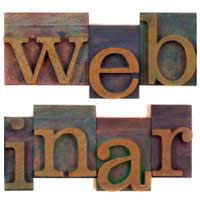Top Tips for Conducting Webinars

A webinar is a live meeting, seminar or presentation conducted on the Internet. The audience pre-book the webinar and log in to their computers at home or work at an agreed time.
Before the Webinar Begins
Ideally, an audience should be sitting in front of their computers before a webinar is due to begin. To ensure this, ask everyone to log in at least two minutes before the speaker appears.During this waiting period, run a series of slides on the screen. These should confirm:
- The time the presentation starts
- The method of asking questions (this may be by phone or by a direct audio link)
- The audience member’s name, photo and job title, if appropriate
Other slides should also build interest by displaying relevant quotes from the speaker.
The Beginning
A good webinar speaker doesn’t begin by introducing him or herself. Instead, the speaker should hook the audience into the webinar with a challenging statement or unusual statistic. The aim is to engage the audience from the very first words.Only then should the speaker say who he or she is. Keep this introduction brief. Don’t linger on experience and qualifications. What the audience really want to know about the webinar is what they will get from it.
Address this point by saying how the webinar will benefit the audience. Also explain how long the webinar will last and when the audience can ask questions.
Slides
Use lots of colourful slides throughout a webinar. Slides keep an audience interested. Watching a speaker, no matter how good he or she is, can become dull.Don’t fill the slides with words. Keep text as concise as possible. Don’t display rows of bullet points, for example. Have no more than one bullet point per slide. This helps the audience consider each point thoroughly.
Connecting With the Audience
A webinar speaker must build a connection with his or her audience. There are a number of ways to do this:- A speaker should make as few references to him or herself as possible. Instead, it is more effective to refer to the audience and use the word “you”. Don’t, for example, say, ‘I am now going to explain how to sell this product to consumers’. Reword such a sentence as follows: ‘You will now discover how you can sell this product to consumers’.
- Stop at appropriate points and ask for questions. This prompts the audience to interact.
- Don’t be vague or pause unnecessarily. Don’t stumble over words. The way to avoid these problems is to write a structure for the webinar and rehearse.
- Include stories and memorable quotes. If the stories are funny, so much the better. An audience will remember these.
- Vary the pace. Variety keeps an audience interested. A steady tone becomes monotonous and boring.
End
At the end of a webinar, summarise what has gone before and clarify any complex issues. Also ensure the audience knows what to do next. Don’t leave the audience in any doubt.Finally, think of a relevant and original quote to use before signing off. Such a quote will stay in the audience’s minds and seal the webinar’s success.
- Communicating the Benefits of a Product, Service or Idea
- How Story Telling Techniques Can Put a Message Across
- Coping With Your Appraisal Meeting
- Questionnaire: Your Skill as a Meeting Facilitator
- How to Run an Effective Meeting
- How to Give a Great Presentation
- Understanding Presentation Software
- All About Teleconferencing
- All About Web Conferencing


Re: How to Deal With Rumours
watcher - Your Question:Recently our workplace has been "managed" by a former workmateshe is quite OTT and particularly intimidates a…
Re: How to Deal With Rumours
recently our workplace has been "managed" by a former workmate she is quite OTT and particularly intimidates a few members of staff,…
Re: Office Politics Almost Ended My Career: A Case Study
Is this a true story? Which company did she work for?
Re: Understanding Harassment in the Workplace
IS indifference by a manager classed as harrasment, she never speaks to me, never asks about deadlines, training,…
Re: Improving Staff Morale
I enjoyed reading the articles. it was very up lifting
Re: All About Web Conferencing
Great article. Web conferencing is a boon for businesses of all kinds. By deploying on premise RHUB web conferencing appliances or…
Re: Beating the Workplace Bullies
I have been bullied for approx five years if not more at work. The problem is when a manager is the ring leader it is hard to not…
Re: Beating the Workplace Bullies
I was bullied in the work place, and it was really bad, my supervisor bullied me and other staff members and I was even stopped…
Re: Asking for a Pay Rise
The point about the level of pay rise is well made. There are generally limits within which there’s some flexibility, usually dependent on…
Re: Questionnaire: Do You Have Good Communication Skills?
add some precise question about communication. good ans....